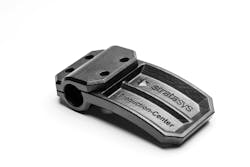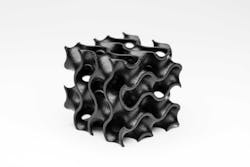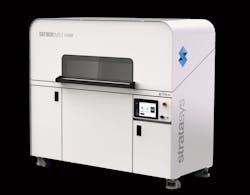Stratasys launches H Series of production-scale 3-D printers
Watch for our Cover Story focusing on innovations in additive manufacturing, coming in the May issue and on plasticsmachinerymanufacturing.com.
By Bruce Geiselman
Stratasys is launching a line of powder-bed-fusion-based 3-D printers appropriate for turning out production parts.
The company’s new H Series Production Platform will use Selective Absorption Fusion (SAF) technology. The first printer in the line, the H350, was introduced April 27 and is expected to ship broadly beginning in the third quarter.
SAF is a new industrial-grade additive manufacturing technology that delivers production-level throughput for end-use parts, according to Stratasys, a manufacturer of 3-D printing systems. The SAF printers, which underwent more than 10 years of R&D, are capable of high-yield production of quality parts at a competitive cost, the company said.
SAF technology uses a counter-rotating roller to coat powder layers onto a print bed. The technology also selectively jets infrared-sensitive, high-absorption fluid (HAF) onto powder on the print bed. Industrial piezoelectric print heads jet single or multiple drops of the fluid in prescribed areas to create each layer of the part. This is followed by exposure to infrared energy, which causes the areas with HAF to melt and fuse together. The sequence is repeated until the parts are completed.
The printer performs all these steps in the same direction across the print bed, which delivers uniform thermal exposure and consistent quality for all parts, regardless of their placement on the print bed, the company said. Curing an entire layer in one sweep of the infrared lamps is one factor that increases the speed of the process.
The H Series Production Platform can process a variety of materials, including polyamides and elastomers. In addition, Stratasys said its relationships with leading chemical companies will help it bring new materials to market quickly.
Stratasys introduced two more new printers on April 27. The F770 FDM printer is targeted at large-part production, and the Origin One is designed for end-use manufacturing applications. Watch for more information about these printers on plasticsmachinerymanufacturing.com.
Contact:
Stratasys, Eden Prairie, Minn., 952-937-3000, www.stratasys.com
Related stories
From prototypes to production, manufacturers harness evolving 3-D technology.
Printing's advantages shine in pandemic, says 3DChimera co-founder.
Rize executives say printing offers personalization at push of a button.
Industry survey finds use of AM is expanding beyond prototyping and R&D.
3YourMind sees a growing market for printing spare parts.
Jabil develops a new high-strength filament to meet customer demand.
Additive manufacturing grew in 2020 despite pandemic, says Wohlers Report.
About the Author
Bruce Geiselman
Senior Staff Reporter Bruce Geiselman covers extrusion, blow molding, additive manufacturing, automation and end markets including automotive and packaging. He also writes features, including In Other Words and Problem Solved, for Plastics Machinery & Manufacturing, Plastics Recycling and The Journal of Blow Molding. He has extensive experience in daily and magazine journalism.


